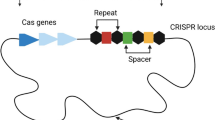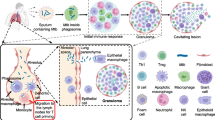Abstract
Toxin–antitoxin systems are widespread in bacteria, including pathogens such as Mycobacterium tuberculosis. The possible functions of the toxin–antitoxin systems in different groups of bacteria can be different and have been actively discussed and refined in recent years. The subject of this work is studying the function of the vapBC2 toxin–antitoxin module genes in M. smegmatis. M. smegmatis mutants with a deletion of the vapBC2 module and a strain with an additional copy of the toxin gene were obtained and studied. It was shown that expression of an additional copy of the toxin gene led to a slowdown in the growth rate, but did not completely inhibit it. These data may indicate a weak RNase activity of the toxin. It was found that the introduction of an additional copy of the toxin gene led to an increase in the sensitivity of M. smegmatis to oxidative stress. The inactivation of the vapBC2 module resulted in increased sensitivity to kanamycin. The introduction of an additional copy of the toxin gene using the pKW08-MCS-Int integrative vector resulted in increased sensitivity to kanamycin, tetracycline, and erythromycin. The determination of the exact mechanism of the vapBC2 module involvement in intrinsic drug resistance/sensitivity is the subject of our further studies.






Similar content being viewed by others
REFERENCES
Le Roux, M., Culviner, P., and Liu, Y., Stress induces the transcription of toxin–antitoxin systems, but does not activate toxin, Mol. Cell, 2020, vol. 79, no. 2, pp. 1—35. https://doi.org/10.1016/j.molcel.2020.05.028
Sala, A., Bordes, P., and Genevaux, P., Multiple toxin—antitoxin systems in Mycobacterium tuberculosis, Toxins, 2014, vol. 6, no. 3, pp. 1002—1020. https://doi.org/10.3390/toxins6031002
Chandra, B. and Ramisetty, M., Regulation of type II toxin—antitoxin systems: the translation-responsive model, Front. Microbiol., 2020, vol. 11, no. 895, pp. 1—6. https://doi.org/10.3389/fmicb.2020.00895
Fernandes-Garcia, L., Blasco, L., Lopez, M., et al., Toxin—antitoxin systems in clinical pathogens, Toxins, 2016, vol. 8, no. 227, pp. 1—23. https://doi.org/10.3390/toxins8070227
Peltier, J., Hamiot, A., Garneau, J.R., et al., Type I toxin—antitoxin systems contribute to the maintenance of mobile genetic elements in Clostridioides difficile, Commun. Biol., 2020, vol. 3, no. 718, pp. 1—13. https://doi.org/10.1038/s42003-020-01448-5
Wang, X., Yao, J., and Sun, Y.C., Type VII toxin/antitoxin classification system for antitoxins that enzymatically neutralize toxins, Trends Microbiol., 2021, vol. 29, no. 5, pp. 388—393. https://doi.org/10.1016/j.tim.2020.12.001
Choi, J.C., Kim, W., Suk, S., et al., The small RNA, SdsR, acts as a novel type of toxin in Escherichia coli, RNA Biol., 2018, vol. 15, no. 10, pp. 1319—1335. https://doi.org/10.1080/15476286.2018.1532252
Mikheecheva, N.E., Zaychikova, M.V., Melerzanov, A.V., and Danilenko, V.N., A nonsynonymous SNP catalog of Mycobacterium tuberculosis virulence genes and its use for detecting new potentially virulent sublineages, Genome Biol. Evol., 2017, vol. 9, no. 4, pp. 887—899. https://doi.org/10.1093/gbe/evx053
Rownicki, M., Lasek, R., Trylska, J., and Bartosik, D., Targeting type II toxin—antitoxin systems as antibacterial strategies, Toxins, 2020, vol. 12, no. 568, pp. 1—16. https://doi.org/10.3390/toxins12090568
Chan, W.T., Balsa, D., and Espinosa, M., One cannot rule them all: are bacterial toxins—antitoxins druggable?, FEMS Microbiol. Rev., 2015, vol. 39, pp. 522—540. https://doi.org/10.1093/femsre/fuv002
Gupta, A., Venkataraman, B., Vasudevan, M., and Bankar, K.G., Co-expression network analysis of toxin-antitoxin loci in Mycobacterium tuberculosis reveals key modulators of cellular stress, Sci. Rep., 2017, vol. 7, no. 5868, pp. 1—14. https://doi.org/10.1038/s41598-017-06003-7
Song, S. and Wood, T.K., A primary physiological role of toxin/antitoxin systems is phage inhibition, Front. Microbiol., 2020, vol. 11, no. 1895, pp. 1—7. https://doi.org/10.3389/fmicb.2020.01895
Prozorov, A.A., Fedorova, I.A., Bekker, O.B., et al., The virulence factors of Mycobacterium tuberculosis: genetic control, new conceptions, Russ. J. Genet., 2014, vol. 50, no. 8, pp. 775—797. https://doi.org/10.1134/S1022795414080055
Fraikin, N., Goormaghtigh, F., and Van Melderen, L., Type II toxin—antitoxin systems: evolution and revolutions, J. Bacteriol., 2020, vol. 202, no. 7, pp. 1—14. https://doi.org/10.1128/JB.00763-19
Wood, T.K., Combatting bacterial persister cells, Biotechnol. Bioeng, 2016, vol. 113, no. 3, pp. 476—483. https://doi.org/10.1002/bit.25721
Jurenas, D. and Van Melderen, L., The variety in the common theme of translation inhibition by type II toxin—antitoxin systems, Front. Genet., 2020, vol. 11, no. 262, pp. 1—19. https://doi.org/10.3389/fgene.2020.00262
Bordes, P., Sala, A.J., and Ayala, S., Chaperone addiction of toxin—antitoxin systems, Nat. Commun., 2016, vol. 7, no. 13339, pp. 1—12. https://doi.org/10.1038/ncomms13339
Rosendahl, S., Ainelo, A., and Horak, R., The disordered C-terminus of the chaperone DnaK increases the competitive fitness of Pseudomonas putida and facilitates the toxicity of GraT, Microorganisms, 2021, vol. 9, no. 375, pp. 1—17. https://doi.org/10.3390/microorganisms9020375
Yu, X., Gao, X., Zhu, K., et al., Characterization of a toxin—antitoxin system in Mycobacterium tuberculosis suggests neutralization by phosphorylation as the antitoxicity mechanism, Commun. Biol., 2020, vol. 3, no. 216, pp. 1—15. https://doi.org/10.1038/s42003-020-0941-1
Bajaj, R.A., Arbing, M.A., Shin, A., et al., Crystal structure of the toxin Msmeg_6760, the structural homolog of Mycobacterium tuberculosis Rv2035, a novel type II toxin involved in the hypoxic response, Acta Crystallogr. F. Struct. Biol. Commun., 2016, vol. 72, pp. 863—869. https://doi.org/10.1107/S2053230X16017957
Fay, A. and Glickman, M.S., An essential nonredundant role for mycobacterial DnaK in native protein folding, PLoS Genet., 2014, vol. 10, no. 7, pp. 1—17. https://doi.org/10.1371/journal.pgen.1004516
Keren, I., Minami, S., Rubin, E., and Lewis, K., Characterization and transcriptome analysis of Mycobacterium tuberculosis persisters, mBio, 2011, vol. 2, no. 3, pp. 1—10. https://doi.org/10.1128/mBio.00100-11
Inoue, H., Nojima, H., and Okayama, H., High efficiency transformation of Escherichia coli with plasmids, Gene, 1990, vol. 96, no. 1, pp. 23—28. https://doi.org/10.1016/0378-1119(90)90336-p
Snapper, S.B., Melton, R.E., Mustafa, S., et al., Isolation and characterization of efficient plasmid transformation mutants of Mycobacterium smegmatis, Mol. Microbiol., 1990, vol. 4, no. 11, pp. 1911—1919. https://doi.org/10.1111/j.1365-2958.1990.tb02040.x
Parish, T. and Brown, A.C., Mycobacteria Protocols, in Methods in Molecular Biology, New York: Humana, 2009, 2nd ed.
Williams, K.J., Joyce, G., and Robertson, B.D., Improved mycobacterial tetracycline inducible vectors, Plasmid, 2010, vol. 64, no. 2, pp. 69—73. https://doi.org/10.1016/j.plasmid.2010.04.003
Lewis, J.A. and Hatfull, G.F., Control of directionality in L5 integrase-mediated site-specific recombination, J. Mol. Biol., 2003, vol. 326, no. 3, pp. 805—821. https://doi.org/10.1016/s0022-2836(02)01475-4
Sambrook, J., Fritsch, E.F., and Maniatis, T., Molecular Cloning: A Laboratory Manual, New York: Cold Spring Harbor Lab., 1989, 2nd ed.
Haimes, J. and Kelley, M., Demonstration of a ΔΔCq Calculation Method to Compute Relative Gene Expression from qPCR Data, Lafayette: A Horizon Discovery Group Comp., 2018.
Sundarsingh, J.A., Ranjitha, J., Rajan, A., and Shankar, V., Features of the biochemistry of Mycobacterium smegmatis, as a possible model for Mycobacterium tuberculosis, J. Infect. Public Health, 2020, vol. 13, no. 9, pp. 1255—1264. https://doi.org/10.1016/j.jiph.2020.06.023
Shur, K.V., Maslov, D.A., Mikheecheva, N.E., et al., The intrinsic antibiotic resistance to β-lactams, macrolides, and fluoroquinolones of mycobacteria is mediated by the whiB7 and tap genes, Russ. J. Genet., 2017, vol. 53, no. 9, pp. 1006—1015. https://doi.org/10.1134/S1022795417080087
Maarsingh, J.D., Yang, S., Park, J.G., and Haydel, S.E., Comparative transcriptomics reveals PrrAB mediated control of metabolic, respiration, energy-generating, and dormancy pathways in Mycobacterium smegmatis, BMC Genomics, 2019, vol. 20, no. 942, pp. 1—16. https://doi.org/10.1186/s12864-019-6105-3
Nguen, L., Antibiotic resistance mechanisms in M. tuberculosis: an update, Arch. Toxicol., 2016, vol. 90, no. 7, pp. 1585—1604. https://doi.org/10.1007/s00204-016-1727-6
Ebbensgaard, A.E., Olesen, A.L., and Moller, J.F., The role of efflux pups in the transition from low-level to clinical antibiotic resistance, Antibiotics, 2020, vol. 9, no. 12, pp. 1—7. https://doi.org/10.3390/antibiotics9120855
Viveiros, M., Martins, M., and Rodriges, L., Inhibitors of mycobacterial efflux pumps as potential boosters for anti-tubercular drugs, Expert Rev. Anti-Infect. Ther., 2012, vol. 10, no. 9, pp. 983—998. https://doi.org/10.1586/eri.12.89
Marsova, M., Abilev, S., Poluektova, E., et al., A bioluminescent test system reveals valuable antioxidant properties of lactobacillus strains from human microbiota, World J. Microbiol. Biotechnol., 2018, vol. 34, no. 27, pp. 1—9. https://doi.org/10.1007/s11274-018-2410-2
Culotta, V.C. and Daly, M.J., Manganese complexes: diverse metabolic routes to oxidative stress resistance in prokaryotes and yeast, Antioxid. Redox Signal., 2013, vol. 19, no. 9, pp. 933—944. https://doi.org/10.1089/ars.2012.5093
Imlay, J.A., Cellular defenses against superoxide and hydrogen peroxide, Annu. Rev. Biochem., 2008, vol. 77, pp. 755—776. https://doi.org/10.1146/annurev.biochem.77.061606.161055
Funding
This work was financially supported by the Russian Foundation for Basic Research (project no. 20-34-90124).
Author information
Authors and Affiliations
Corresponding authors
Ethics declarations
The authors declare that they have no conflicts of interest. This article does not contain any studies involving animals or human participants performed by any of the authors.
Additional information
Translated by D. Novikova
Rights and permissions
About this article
Cite this article
Akimova, N.I., Bekker, O.B. & Danilenko, V.N. Functional Significance of Mycolicibacterium smegmatis Toxin–Antitoxin Module in Resistance to Antibiotics and Oxidative Stress. Russ J Genet 58, 547–557 (2022). https://doi.org/10.1134/S1022795422050027
Received:
Revised:
Accepted:
Published:
Issue Date:
DOI: https://doi.org/10.1134/S1022795422050027




